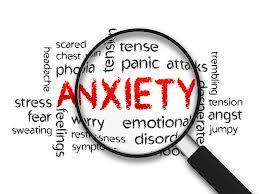Anxiety disorders are collectively the most prevalent psychiatric disorders in the United States. The lifetime prevalence rate of anxiety disorders is 14.6% with associated treatment costs of billions of dollars. Anxiety is a diffuse, unpleasant, and often vague subjective feeling of apprehension accompanied by objective symptoms of autonomic nervous system arousal. The experience of anxiety is associated with a sense of danger or a lack of control over events. Untreated anxiety disorders cause a significant number of productive years of life to be lost or impaired, which carries a high cost for society.
Anxiety is pathologic when it occurs in situations that do not call for fear or when the degree of anxiety is excessive for the situation. Anxiety may occur as a result of life events, as a symptom of a primary anxiety disorder, as a secondary response to another psychiatric disorder or medical illness, or as a side effect of a medication.
W.B. Cannon's theory asserts that humans evolved with the tendency for emergency situations to provoke an increase in sympathetic nervous system activity, commonly known as the fight-or-flight response. Many anxiety disorders seem to involve alterations in the physiology of the hypothalamic-pituitary-adrenal axis. However, it is likely that the different anxiety disorders have related but not identical etiologies.
Behavioral and cognitive explanations define anxiety as a learned response. Anxiety develops in response to neutral or positive stimuli that become associated with a noxious or aversive event. Fearful associations develop from the situational context and the physical sensations present at the time. The patient may generalize (ie, classify objects and events based on a common characteristic) and thereby establish new cues to trigger anxiety. Previously neutral situations become feared and avoided. By avoiding anxiety-arousing stimuli, anxiety is diminished.
Training in stress inoculation, relaxation training, and cognitive-behavioral therapy can be implemented through an integrated curriculum in public education during the early and middle years. School settings provide furtive environments for group modeling and an opportunity to reach large numbers of people.
To control your anxiety think about the positive things that are going on in your life. Think about these things when you lay down to bed and when you get up in the morning. Keeping positive thoughts gets rid of negative thoughts, which gets rid of the negative feelings that cause your anxiety.
Control your emotions more with self-discipline. You’ll have far more control over all anxiety attacks once you have garnered some control and influence over your emotions. Negative feelings will only make you more stressed out. Detach from your emotions periodically to reduce anxiety.

Recommended treatment includes breathing retraining, cognitive restructuring, interceptive exposure, and relaxation training.
These are some simple methods to control your anxiety :
1. Sit with your eyes closed and turn your attention to your breathing. Breathe naturally, preferably through the nostrils, without attempting to control your breath.
2. Be aware of the sensation of the breath as it enters and leaves the nostrils. Place one hand on your belly, and the other on your chest. Take a deep breath for a count of four. Hold your breath for a count of three. Exhale for a count of four. The hand on your belly should go in as you inhale, and move out as you exhale.
3. Concentrate on your breath and forget everything else. Your mind will be very busy, and you may even feel that the meditation is making your mind busier, but the reality is you're just becoming more aware of how busy your mind is.
4. Resist the temptation to follow the different thoughts as they arise, and focus on the sensation of the breath. If you discover that your mind has wandered and is following your thoughts, immediately return it to the breath.
5. Repeat this as many times as necessary until your mind settles on the breath.
Don't wait to begin belly-breathing. The sooner you make this a daily habit, the quicker you'll feel relaxed.
Complications of anxiety disorders generally arise from failure to make the diagnosis or from inadequate treatment. Anxiety disorders are associated with increased utilization of healthcare services and can be immensely disabling. An anxiety disorder may have a significant negative impact on a patient's quality of life.
Just 30 years ago, most estimates were that 80% of patients with anxiety disorders would not significantly benefit from available treatment. Today the opposite is true. For the majority of patients with anxiety disorders treatment with a combination of cognitive-behavioral therapy and medical therapy carries an excellent prognosis .
